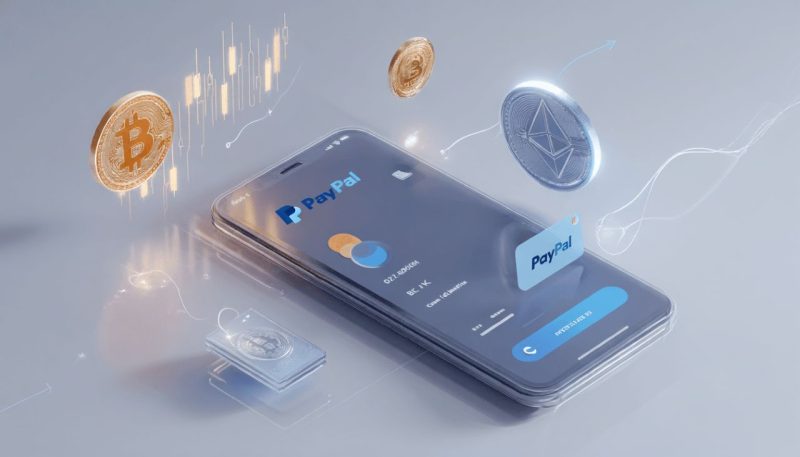
PayPal recently introduced its new payment links feature. Those links let users send or receive money with just a short URL. What’s new is the option to use crypto like Bitcoin, Ethereum, and PayPal’s own stablecoin PYUSD. The fee is charged in fiat currency based on the Bitcoin price at the time of receipt, making Bitcoin price performance an important factor for both merchants and users considering the volatility of settlement.
The initiative may mean more than simply adding crypto. It appears to combine new tools, a clean design, and a backend that mixes regular payments with blockchain settlement. And that could become a turning point for daily crypto use, if the rollout lives up to the promise — for users worldwide.
According to PayPal’s statements and recent news, the company intends to let users move crypto via Paypal links:
- Users can send digital coins from PayPal to Venmo, or even to external wallets.
- Recipients might receive the crypto straight into their wallets.
- The service also includes automatic conversion, so merchants could have payments turned into PYUSD or regular currency to avoid volatility.
- PayPal says it will use stablecoin routing, likely through the Stellar network, to keep fees low and settlement quick. In some cases, a 0.99 % charge is noted, which suggests the firm is trying to stay competitive in the current market.
Why This Might Be Innovative
For many people, crypto payments are still unusual. Long wallet addresses, gas fees, waiting times, key juggling complex processes. PayPal’s new payment‑links seem to act like a simple “send money” button.
The sender just clicks, the receiver approves. No need to know blockchain details. It probably lowers the learning curve. Some may still worry about security, but the ease could draw more everyday users. Therefore, traditional business owners might accept crypto.
PayPal already has more than 430 million users worldwide. Venmo, its sister app, adds more users to this base. By letting outside wallets join, PayPal appears to push for interoperability instead of a closed system. Analysts point out that this shift is already visible in the crypto heatmap, which highlights growing user flows between Bitcoin, Ethereum, and stablecoins across multiple platforms. That could matter: the more places crypto can be used for payments, the more people might treat it as a payment tool, not just a digital asset.
Therefore, processors like Visa or Mastercard feel pressure. They usually impose merchant fees, card‑holder fees, and foreign‑exchange charges. If PayPal can offer crypto payments with a lower total price, merchants and shoppers may start to shift. Yet, regulators might still raise questions about safety.
Of course, this new crypto feature from PayPal faces some challenges:
- Regulators watch closely: Money‑laundering rules, identity checks, and stablecoin rules all need compliance. PayPal has to meet both U.S. and foreign regulations, a task that may remain unclear in many places.
- Holders matter: When PayPal converts a user’s crypto into PYUSD or regular currency, the company becomes the custodian. That adds a centralization risk and makes users question trust.
- Liquidity is a worry: Big purchases or rare tokens could cause slippage, giving worse exchange rates. Maintaining sufficient stablecoin liquidity is therefore essential.
- Merchants must agree: They need tools to accept the payment method, adjust their accounting, handle taxes, and maybe maintain some stablecoins. Without enough merchants, the system stalls.
- People need guidance: Many fear scams, price swings, and tech glitches. Even a smoother app experience will need education before users feel safe.
The “pay via a link” crypto initiative goes far beyond PayPal’s platform. That could move crypto from a niche tool to everyday use, like tips and online orders.
Stablecoins such as PYUSD will become more than a novelty. They act like a bridge for real‑time payments and may prompt regulators to finally write clearer rules. Meanwhile, rivals like Stripe, Adyen, Square, and even Apple and Google could be compelled to add their own crypto solutions. That pressure might spark fresh ideas and lower the fees people pay.
Emerging markets could see the biggest benefit. Where banks are weak and sending money abroad costs too much, a crypto or stablecoin route might be faster, cheaper, and more open. PayPal could serve as a catalyst, but local adoption will still depend on internet access and trust in new tech. The outcome remains uncertain.
In the next few years, several things may decide if it works. First, how many merchants and shop owners enable the crypto option. Second, whether the fees stay low enough compared to a standard credit card. Also, people might prefer an automatic swap to stablecoins or cash instead of keeping raw crypto assets. Third, the speed and cost of moving money across borders, and whether regulations stay stable.
If PayPal can achieve these goals, the service could push crypto toward being a real money tool, rather than just a speculative asset. Yet the plan will face close regulatory oversight, user adoption rates, and the company’s capacity to maintain trust, liquidity, and user experience.
